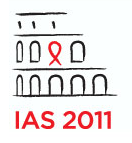Maraviroc plus atazanavir/r without nukes versus standard of care: 48 week results
1 August 2011. Related: Conference reports, Antiretrovirals, IAS 6th Rome 2011.
 Simon Collins, HIV i-Base
Simon Collins, HIV i-Base
Updated results from a Pfizer-sponsored study of dual therapy maraviroc plus atazanavir/r compared to standard of care atazanavir/r plus tenofovir/FTC were presented at the meeting.
This is controversial due to the lower percentage of patients in the maraviroc arm reaching undetectable viral load <50 copies/mL at week 48 (75% vs 84%, no between arm statistical data presented due to lack of power in the study size), higher rates of toxicity and the decision to enroll a larger phase 3 study with the same design. These differences were also seen at week 48 when stratified by baseline viral <100,000 (77% vs 87%) and >100,000 (69% vs 77%).
These trends were apparent in the interim 24-week results presented at the IAS 2010 in Vienna: viral suppression then was 80 vs 89% together with increased side effects (ie 33% vs 23% grade 3/4 including 26% vs 13% hyperbilirubinaemia) in the maraviroc arm. [2]
A health economic interest in this study comes from the pharmacokinetic data supporting the use of half-dose (and therefore half-cost) maraviroc (patients are dosed at 150 mg daily when using atazanavir/r) and that in this combination maraviroc is only taken once daily.
Mean change from baseline in CD4 count at week 48 was similar with +215 vs +226 cells/mm3 in the maraviroc vs tenofovir/FTC arms respectively.
Grade 3/4 side effects were more frequent with maraviroc than tenofovir/FTC (18 vs 11 patients) and these were mostly due to hyperbilirubinemia. Creatinine clearance was stable with maraviroc but decreased by a median 12 mL/min with tenofovir/FTC. Serious adverse events were similar (10 vs 11 patients) with none related to assigned study drug.
A second presentation included an analysis of the results from patients who used 150 mg maraviroc with boosted PI, supporting the reduced dose compared to those using 300 mg twice-daily with either tipranavir or fosamprenavir in the maraviroc registrational trials. [3]
In summary, suppression to <50 copies/mL was reported in 45% vs 47% in the 150 mg/boosted PI vs 300 mg groups (vs 16% for the placebo group) with a similar close relationship between doses for people starting in advanced disease with baseline viral load >100,000 copies/mL (38% vs 39%) or CD4 counts <50 cells/mm3 (17% vs 18%).
comment
The limitations from low study numbers in phase 2 studies are important to remember when reviewing these results but it will be important to follow the phase 3 study of this dual therapy arm carefully. Some combinations that are less virologically effective perform better as switch options once people are stable on treatment.
A switch strategy, given the potential cost savings from the reduced dose of maraviroc might warrant a separate study.
References
- 1. Mills A et al. 48-week results of a dual-therapy regimen of once-daily maraviroc (MVC) 150 mg in combination with ritonavir-boosted atazanavir (ATV/r) compared to emtricitabine/tenofovir (FTC/TDF) + ATV/r in treatment-naive (TN) patients infected with CCR5-tropic HIV-1 (Study A4001078). 6th IAS Conference, 17–20 July 2011, Rome. Abstract TUAB0103. Webcast.
- Portsmouth S et al. Safety and immunovirological activity of once daily maraviroc (MVC) in combination with ritonavir-boosted atazanavir (ATV/r) compared to emtricitabine 200mg/tenofovir 300mg QD (TDF/FTC) + ATV/r in treatment-na patients infected with CCR5-tropic HIV-1 (Study A4001078): A week 24 planned interim analysis. 18th IAS Conference, 18–23 July 2010, Vienna. Late breaker abstract THLBB203.
- Taylor S et al. Efficacy of maraviroc (MVC) administered once daily (QD) or twice daily (BID) with boosted protease inhibitors (bPIs) to treatment-experienced patients. 6th IAS Conference, 17–20 July 2011, Rome. Abstract TUAB0106.

